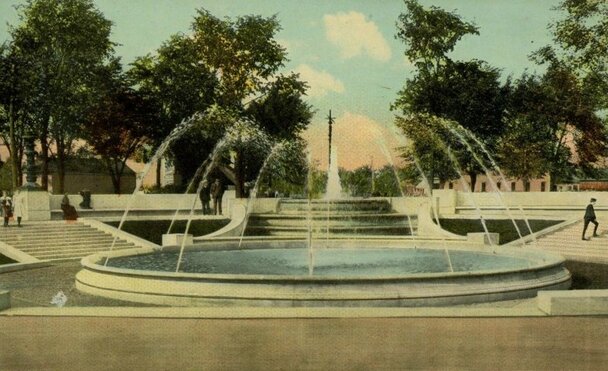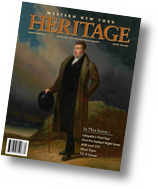
Postcard featuring Gates Circle, ca. 1910, showing the central fountain and surrounding steps and benches.
Credit - Western New York Heritage Press
Frederick Law Olmsted and Calvert Vaux’s plan for radiating parkways called for each to terminate in a circle which, by the end of the 19th century, had become highly desirable addresses in the city.
Each of these terminal points was originally named for the same officer who was memorialized in the corresponding parkway. Thus Bidwell Parkway terminated in Bidwell Place, while Chapin Parkway terminated in Chapin Place.
With the approach of the Pan-American Exposition and the increased visibility the parkways would likely receive as avenues of access to the event, the city’s park commissioners considered improvements to Chapin Place, including the erection of a statue of Lafayette, “or some man prominent in the early life of Buffalo.”
Fate, however, would decree otherwise.
In 1902, the year following the Exposition, a generous female benefactor came forth with an alternative proposition. Rather than a statue, Mrs. Charles Pardee—who lived nearby on Delaware Avenue, at the corner of Hodge Street—suggested the construction of an elaborate fountain in the center of Chapin Place.
As with many large contributions, however, there was a catch. Mrs. Pardee expressed her willingness to commission the architectural firm of Green & Wicks to design the fountain, and to pay for its construction, provided that the name of the location be changed from Chapin Place to Gates Circle, in honor of her mother, Elizabeth Gates.
The widow of railroad executive George Gates, Elizabeth had long been recognized as one of the city’s generous benefactors, and was particularly known for her work in aiding the poor and for her support of the Buffalo General Hospital.
Not surprisingly, given the original memorial intent of the parkways, there were those who objected to the name change. Particular protest came from the ranks of the GAR, the prominent Civil War veterans’ organization.
Nonetheless, the commissioners accepted Mrs. Pardee’s offer and the location has been known as Gates Circle ever since. The resulting Green & Wicks fountain was an ornate design, incorporating lights and other elements from the recent Pan-American Exposition.
In addition to the beauty of the fountain complex, it is said that the circle boasts the only known “whispering gallery” in the city. Such galleries—where soft voices may be heard at greater distances due to the acoustical configuration of the space—are not uncommon in large churches.
In the case of Gates Circle, it is said that a person sitting in one of the outermost circular benches surrounding the fountain may be heard from some distance, at least within the unbroken segments of the seats.













